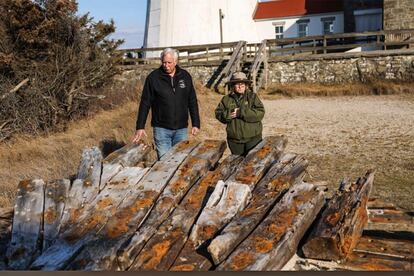Flotsam found off New York may be from famous SS Savannah
Explorers have searched for the Savannah for over two centuries but have not found anything they could definitively link to the famous ship

A chunk of weather-beaten flotsam that washed up on a New York shoreline after Tropical Storm Ian last fall has piqued the interest of experts who say it is likely part of the SS Savannah, which ran aground and broke apart in 1821, two years after it became the first vessel to cross the Atlantic Ocean partly under steam power.
The roughly 13-foot (4-meter) square piece of wreckage was spotted in October off Fire Island, a barrier island that hugs Long Island’s southern shore, and is now in the custody of the Fire Island Lighthouse Preservation Society. It will work with National Park Service officials to identify the wreckage and put it on public display.
“It was pretty thrilling to find it,” said Betsy DeMaria, a museum technician at the park service’s Fire Island National Seashore. “We definitely are going to have some subject matter experts take a look at it and help us get a better view of what we have here.”

It may be difficult to identify the wreckage with 100% certainty, but park service officials said the Savannah is a top contender among Fire Island’s known shipwrecks.
Explorers have searched for the Savannah for over two centuries but have not found anything they could definitively link to the famous ship. The newly discovered wreckage, though, “very well could be” a piece of the historic shipwreck, said Ira Breskin, a senior lecturer at the State University of New York Maritime College in the Bronx. “It makes perfect sense.”
Evidence includes the 1-to-1.3-inch (2.5-to-3.3-centimeter) wooden pegs holding the wreckage’s planks together, consistent with a 100-foot (30.5-meter) vessel, park service officials said in a news release. The Savannah was 98 feet, 6 inches (30 meters) long. Additionally, the officials said, the wreckage’s iron spikes suggest a ship built around 1820. The Savannah was built in 1818.
Breskin, author of “The Business of Shipping,” noted that the Savannah’s use of steam power was so advanced for its time that the May 24, 1819, start of its transatlantic voyage is commemorated as National Maritime Day. “It’s important because they were trying to basically show the viability of a steam engine to make it across the pond,” he said.
Breskin said a nautical archaeologist should be able to help identify the Fire Island wreckage, which appears likely to be from the Savannah. “It’s plausible, and it’s important, and it’s living history if the scientists confirm that it is what we think it is,” he said.
The Savannah, a sailing ship outfitted with a 90-horsepower steam engine, traveled mainly under sail across the Atlantic, using steam power for 80 hours of the nearly month-long passage to Liverpool, England.
Crowds cheered as the Savannah sailed from Liverpool to Sweden and Russia and then back to its home port of Savannah, Georgia, but the ship was not a financial success, in part because people were afraid to travel on the hybrid vessel. The Savannah’s steam engine was removed and sold after the ship’s owners suffered losses in the Great Savannah Fire of 1820.
The Savannah was transporting cargo between Savannah and New York when it ran aground off Fire Island. It later broke apart. The crew made it safely to shore and the cargo of cotton was salvaged, but the Augusta Chronicle & Georgia Gazette reported that “Captain Holdridge was considerably hurt by being upset in the boat.”
Explorers have searched for the Savannah over the two centuries since it but have not found anything they could definitively link to the famous ship. The newly discovered wreckage, though, “very well could be” a piece of the historic shipwreck, Breskin said. “It makes perfect sense.”
Sign up for our weekly newsletter to get more English-language news coverage from EL PAÍS USA Edition
Tu suscripción se está usando en otro dispositivo
¿Quieres añadir otro usuario a tu suscripción?
Si continúas leyendo en este dispositivo, no se podrá leer en el otro.
FlechaTu suscripción se está usando en otro dispositivo y solo puedes acceder a EL PAÍS desde un dispositivo a la vez.
Si quieres compartir tu cuenta, cambia tu suscripción a la modalidad Premium, así podrás añadir otro usuario. Cada uno accederá con su propia cuenta de email, lo que os permitirá personalizar vuestra experiencia en EL PAÍS.
¿Tienes una suscripción de empresa? Accede aquí para contratar más cuentas.
En el caso de no saber quién está usando tu cuenta, te recomendamos cambiar tu contraseña aquí.
Si decides continuar compartiendo tu cuenta, este mensaje se mostrará en tu dispositivo y en el de la otra persona que está usando tu cuenta de forma indefinida, afectando a tu experiencia de lectura. Puedes consultar aquí los términos y condiciones de la suscripción digital.
Archived In
Últimas noticias
The Bolsonaro surname: An advantage or liability in Brazil’s 2026 presidential elections?
Raúl Rocha, from jet-setting with Miss Universe to arms trafficking and fuel theft
80,000 barrels of Mexican oil sent to Cuba: Havana drawn into the US–Mexico clash
Human rights activists, opposition members, and a minor: Maduro’s other political prisoners
Most viewed
- Reinhard Genzel, Nobel laureate in physics: ‘One-minute videos will never give you the truth’
- Pablo Escobar’s hippos: A serious environmental problem, 40 years on
- Charles Dubouloz, mountaineering star, retires at 36 with a farewell tour inspired by Walter Bonatti
- Why we lost the habit of sleeping in two segments and how that changed our sense of time
- The fall of a prolific science journal exposes the billion-dollar profits of scientific publishing








































